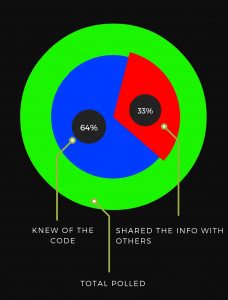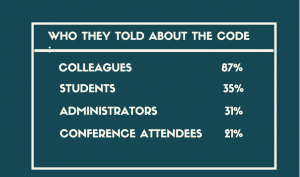How much difference has the release of the College Art Association’s release of the Code of Best Practices in Fair Use for the Visual Arts made so far? Even a few months after the release in February 2015, there was
significant change in the field’s practice.
A survey of more than two thousand members of the College Art Association, starting seven months after the launch of the Code and winding up in January 2016, was analyzed by American University faculty and graduate students. Here’s what we know:
By and large, and as expected, patterns documented in a 2013 survey remained in place in the few months after the CAA Code was launched. The great majority of visual arts professionals still default to permissions, even though they have some experience of fair use when permissions processes fail. That choice is often costly. About a third of the respondents continue to report problems with avoiding projects, abandoning existing projects, and serious delays of more than three months, because of permissions.
But as well, we saw some real changes.
-
The Code spurred a significant group of people to try fair use for the first time. Some 11% of those who have employed fair use did so for the first time after the Code came out.
-
The Code spurred institutions to revise their policies. More than half—57%–of respondents who reported some institutional policy change said it had happened after the Code was released.
-
Editors reported the largest amount of change, of any occupational group. This reflects the fact that several institutions publicly announced a change in policy, including the College Art Association. CAA’s author agreement now encourages a default to fair use where in line with the Code.

2/3 Knew about the Code
These changes, which occurred after only months of experience with the Code, happened because of widespread and networked knowledge.
o Two-thirds of respondents said they had heard of the Code before they took the survey.
o Most heard from multiple sources, but CAA was the most common source, whether through the conference, a newsletter or the website.
o A third of those who had heard about it had shared the news with someone else—a gesture that shows trust in the information, and confidence that it will be useful.
o Mid-career and veteran members of the field were much more likely to have heard about it than the newer entrants.

This is only the beginning, though. There’s still a lot to do.
-
More than a fifth of respondents said they simply did not know whether fair use was valuable or not in their work. For a tool so fundamental to the functioning of the field, that is an alarming information gap.
-
Only half of those who had heard about the Code went on to use it in the months after its release.

The survey results provide some next steps:
-
Knowledge matters. The more confident and grounded respondents are in their understanding of fair use, the more likely they are to use it. So sharing your knowledge about the Code is crucial.
-
Veteran leadership matters. Newer entrants to the field are less likely to have heard about the Code or to have experience with fair use.
-
It’s worthwhile investing in the newest entrants. Although they were less familiar with the Code or fair use, they were the most likely to recognize that fair use is valuable to their work. They also are the most likely, they say, to change behavior with greater confidence in their knowledge.
-
Institutions are really important in changing practices–to set terms, spread the word, and by publicly announcing their decisions to give confidence to others.
-
Higher education is particularly important, especially for those, like artists, who may not be consistently working within institutions as they develop their careers. Universities, colleges, and art schools can educate the next generation about the new normal.
